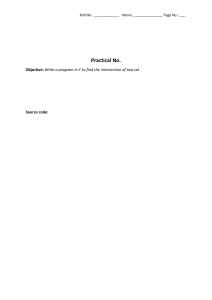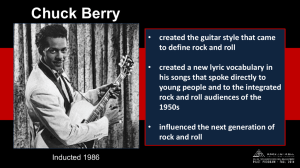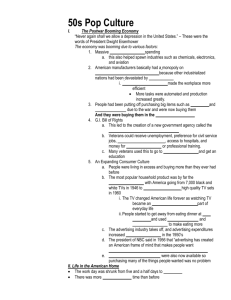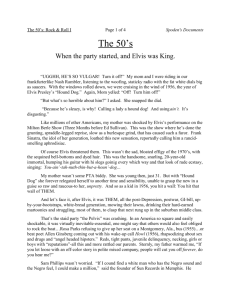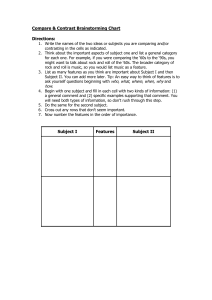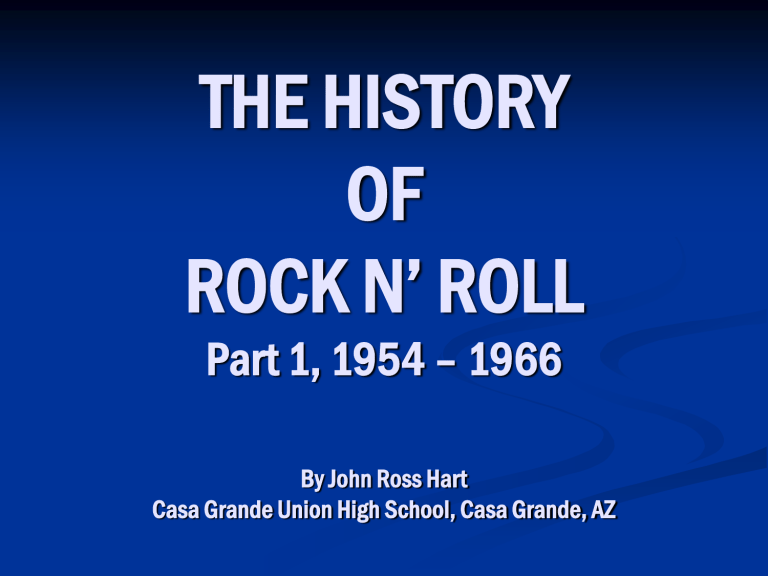
THE HISTORY OF ROCK N’ ROLL Part 1, 1954 – 1966 By John Ross Hart Casa Grande Union High School, Casa Grande, AZ Objective: Students will be able to identify those factors that brought forth the genre of rock n’ roll and the effect it would have on society for the remainder of the 20th Century Vocabulary: Frank Sinatra Beatniks James Dean Elvis Presley Chuck Berry Pat Boone Alan Freed Buddy Holly American Bandstand Payola Scandal Teen Idol The Beach Boys The Motown Sound Bob Dylan The Beatles The British Invasion Garage Rock James Brown Bill Drake Casa Grande Union High School Students Only: You will be watching and listening to a PowerPoint presentation about the early days of Rock n’ Roll, which developed in the 1950’s. This is a relatively fast-moving presentation so stay focused and quick with your notes. First… 1. What do you know about the roots of rock n’ roll? 2. What name comes to mind when you think of early rock n’ roll? 3. Can you name at least one early rock or blues song? 4. Why do you think the older generation did not like this music? 5. Why do you think the “War Baby” and “Baby Boom” generation embraced it? Second… As you watch and listen, write down at least 20 notable names and/or songs that established a genre that would continue through the remainder of the 20th Century. The war was over! Soldiers were coming home Many were starting families People were moving to the suburbs Some took advantage of the G.I. Bill and furthered their education A new generation was evolving This new generation had questions… about society, morality, and authority The new generation rejected the music of their parents Tommy Dorsey Dinah Shore Frank Sinatra: The superstar of his generation Instead, they were listening to Ike Turner’s “Rocket 88” In the coffee houses of San Francisco’s North Beach, the “Beatniks” rebelled against everything that came before… using coffee, pot, and obscenity to spread their message At “City Lights Books,” Lawrence Ferlinghetti not only dared to print the books, but he also sold them and offered open readings by their authors “Howl” by Allen Ginsberg opened up his own and the overall subject of homosexuality In “On The Road,” Jack Kerouac went looking for America but didn’t like what he saw On the silver screen, Marlon Brando and James Dean became legendary rebels in “The Wild Ones” and “Rebel Without A Cause” More and more, white kids were listening to black rhythm and blues Sonny Boy Williamson Howlin’ Wolf Muddy Waters Ray Charles Ivory Joe Hunter In 1954, Big Joe Turner recorded “Shake, Rattle, and Roll” A few months later, a country band named Bill Haley and the Comets recorded the same song Bill Haley and the Comets received more radio airplay and sold more records “If I could find a white boy who could sing like a black man, I could make a million dollars” SAM PHILLIPS, SUN RECORDS In Chicago, the “R & B” scene was heating up l-r Chuck Berry, Little Richard, Bo Diddley In New Orleans, Fats Domino was the rage All four recorded songs that became classics But another country artist, Pat Boone, covered their songs, got more airplay, and sold more records If you wanted to listen to rhythm and blues, you had to tune in to weak-powered AM stations from the big cities to hear the original hits Mainstream disc jockeys did not play rhythm n’ blues and were threatened with termination and “blacklisting” if they did But a Cleveland disc jockey named Alan Freed dared to play the music on his evening show, calling it “rock n’ roll” Meanwhile, Elvis Presley’s first records made him a regional superstar On the Louisiana Hayride With Bill Black and Scotty Moore along with Sam Phillips In fact, Sam Phillips was putting together a stable of other talented artists L-r Jerry Lee Lewis, Carl Perkins, Elvis Presley, Johnny Cash Later, Phillips signed Roy Orbison Elvis became so big, Sun Records could no longer afford to record or promote him, so his contract was sold to the larger RCA Victor Records Elvis’ first recording for RCA Victor was “Heartbreak Hotel,” which quickly became a worldwide number one hit, the first of 30 But many adults found Elvis’ gyrations on stage revolting In fact, when Elvis appeared on the nationally popular Ed Sullivan Show, his act was only shown from the waist up! Carl Perkins recorded “Blue Suede Shoes,” but after nearly being killed in a car accident, Elvis would take his place and sing the song on the Ed Sullivan Show “Great Balls of Fire!,” wildman Jerry Lee Lewis could put on a show The real King? Chuck Berry was mixing R n’ B with Country Music Though still rhythm and blues artists at heart, Chuck Berry, Little Richard, Bo Diddley, and Fats Domino were now considered Rock n’ Roll artists Others were encouraged to play the music Wanda Jackson could rock with the big boys Ricky Nelson had the advantage of his parent’s TV show Gene Vincent and the Burnette Brothers were pure “rockabilly” Eddie Cochran had an acting background The Innovators who left an influence The Everly Brothers sang of teenage innocence in perfect harmony Coolidge’s own, Duane Eddy influenced all guitarists who followed Off the street corners of Brooklyn, Dion was the king of “Doo Wop” Initially, Richard Berry made no money on his song, “Louie Louie,” but later success by others made him rich Groups such as the Drifters and the Coasters were popular Smooth-sounding Sam Cooke would score over 30 Top 40 hits But Elvis Presley was the King of Rock n’ Roll Then along came a bespectacled singer, guitar player, songwriter from Lubbock, Texas Unlike Elvis, Buddy Holly could sing, plus play lead guitar, write his own songs, and could also produce his own records Buddy leads the Crickets, Joe B. Maulden on bass and Jerry Allison on drums, in their first appearance on “American Bandstand” In Philadelphia, kids were dancing on local television to rock n’ roll records played by a young disc jockey named Dick Clark. In 1957, “American Bandstand” went coast-to coast on ABC Gordon McClendon developed the Top 40 radio format, Todd Storz adjusted it for rock n’ roll, Chuck Blore tightened the programming Early Top 40 Disc Jockeys WMCA New York was the nation’s #1 station Tommy Edwards (l) and Wink Martindale not only played records, but had their own hits Art Laboe Rocked Southern California Hy Lit became a Philadelphia radio legend Then the music died! Elvis was drafted into the Army Chuck Berry was imprisoned for violating the Mann Act Jerry Lee Lewis was banned on the radio for marrying his 14-year-old cousin Eddie Cochran was killed in a car crash Buddy Holly, J.P. “Big Bopper” Richardson, and Richie Valens were killed in a plane crash after doing a show in Clear Lake, Iowa It was Rock n’ Roll’s First Tragedy The music moguls and the “establishment” now moved to get rid of rock n’ roll once and for all A congressional committee called together several notable disc jockeys asking them if they had accepted money to play rock n’ roll records on their shows. Alan Freed was made an example of by the committee, was fired by his radio station, and became destitute leading to his early death. Enter the clean-cut, innocent, teen idol Clockwise from Top left: Frankie Avalon, Bobby Rydell, Bobby Vee, Bobby Darin, Paul Anka, Jimmy Clanton, Bobby Vinton And a couple of pretty girls… Connie Francis and Brenda Lee became the first female stars of the Rock Era But in Southern California, the Beach Boys sang about surfing, cars, and girls In Detroit, a former Ford assembly line worker started “The Motown Sound” The Supremes Martha and The Vandellas Smokey and the Miracles Marvin Gaye Berry Gordy: The Father of Motown The Four Tops A Hollywood teenager named Phil Spector developed a “Wall of Sound” with artists that included The Ronettes, The Righteous Brothers, and Sonny and Cher Folk music spoke of the times The Springfields Dusty would later go on to a successful pop career The Kingston Trio Peter, Paul, and Mary Chad Mitchell Trio Cynical, angry, rebellious, marching to the beat of his own drum… Bob Dylan would speak for a generation So what was the big deal? The Kingsmen were not the first (or the last) to record “Louie Louie,” but their version raised the most controversy. According to legend, the song was recorded at a different “time,” was slurred to cover profanity or hidden messages, and a written copy was passed amongst teen audiences. The song reached number one nationally despite being banned by several radio stations, and the Governor of Indiana. The FBI began investigating the song and the band but eventually found the song to be “Highly Unintelligible.” Meanwhile, in Liverpool, a tough but faded English seaport, the kids still wanted to hear rock n’ roll Rory Storm and The Hurricanes featured Ringo Starr on drums Gerry and The Pacemakers The Searchers The biggest of the groups was The Beatles l-r George Harrison, Paul McCartney, Pete Best, John Lennon But record moguls in London continually turned down The Beatles and other British groups hoping to record their music It was George Martin, a producer for a comedy label named “Parlophone” who saw “something. “Love Me Do” reached #17 on the British charts. But before they started recording, Ringo Starr replaced Pete Best as their drummer. Their next record, “Please Please Me” began an eight-year run of #1 hits Capitol Records, which owned the rights to Parlophone and EMI refused to release The Beatles in America because they didn’t think they would sell! However, The Beatles had become so huge not only in Britain, but all over Europe. Even Ed Sullivan, who hosted the top-rated variety show on Sunday nights couldn’t overlook their phenomenon. Capitol finally released “I Want to Hold Your Hand,” which went to #1 on the Billboard charts. Other British acts would follow The Rollingstones The Animals The Who The Yardbirds Spencer Davis Group America also had some groups that rocked Paul Revere & The Raiders The Association The Lovin’ Spoonful The Byrds The Monkees Garage Bands: Influenced by the Beatles, practicing in your next door neighbor’s garage The Turtles: Happy Together The Grassroots scored 18 Top 40 hits The Seeds: They had more hair than anyone Count 5 copied The Yardbirds America also had soul Aretha Franklin, The Queen James Brown, The Godfather of Soul Booker T. & The MG’s Otis Reading Sam and Dave But no one ruled the charts like The Beatles More platter, less chatter, Bill Drake gave us “Boss Radio” Robert W. Morgan and The Real Don Steele starred at Drake’s KHJ in Los Angeles Cousin Brucie (Morrow) covered the eastern seaboard during his evening show on WABC Out West, Wolfman Jack “howled” nightly with 100,000 AM watts from Rosarito, Mexico And the kids were dancing to the Twist, Mashed Potatoes, Hully Gully, Watusi, Monkey, Slauson, Jerk, and the Skate, amongst others END OF PART I 1. What was notable about the postwar generation? 2. How did postwar teens see Frank Sinatra? 3. These people questioned authority and the status quo? 4. Name two legendary rebels of the silver screen? 5. Name an early rhythm and blues performer? 6. Sam Phillips claimed this would make him a million dollars? 7. Name one artist from the heated-up Chicago blues scene? 8. Why was it hard to hear black rhythm and blues? 9. What Cleveland disc jockey dared to play the music he called “rock n’ roll?” 10. Name one other artist produced by Sam Phillips? 11. What happened to Elvis when he appeared on the Ed Sullivan Show? 12. Name the guitar player from Coolidge who influenced all rock n’ roll guitarists who followed? 13. Name at least one thing Buddy Holly could do that Elvis couldn’t do? 14. Who were Gordon McClendon, Todd Storz, and Chuck Blore? 15. What happened to Buddy Holly? 16. What was the Payola Scandal? 17. What spawned the “Teenage Idol?” 18. What did the Beach Boys sing about? 19. Who started Motown Records? 20. Who became known as “The Voice of a Generation?” 21. Why were the Beatles (and other Liverpool groups) unable to land recording contracts? 22. Name at least two other British acts? 23. Name two popular American groups at this time? 24. Who became known as “The Godfather of Soul?” 25. Name a popular disc jockey or radio programmer from the 1960’s?
